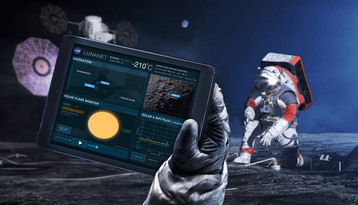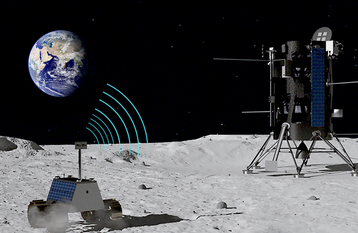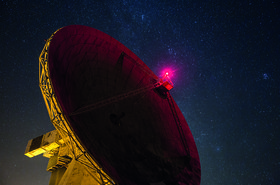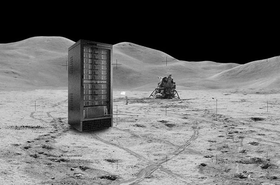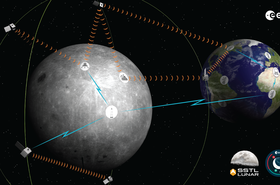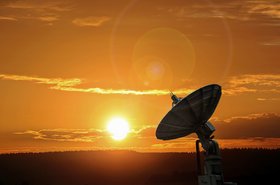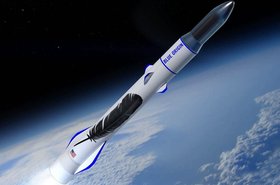It’s time for the Moon to get online. NASA is embarking on an ambitious project to build an Internet for the Moon, opening up its far side, setting the groundwork for human habitation, and preparing us for connected civilizations on Mars.
We don’t have much in the way of operating technology on the Moon, but what little we have keeps in touch by direct communication with Earth. "So far, all of the existing lunar stuff has been direct-to-Earth,” NASA exploration and space communications projects division architect David Israel told DCD.
This article appeared on the cover of Issue 39 of the DCD>Magazine. Subscribe for free today
The dark side of the Moon
There are two notable exceptions - China’s Chang'e 4, which achieved humanity's first soft landing on the far side of the Moon in 2019, and last year’s follow up, which both used the Queqiao Relay Satellite to pull off their feat. “But for our missions, right now, we don't have any relay capability,” Israel said.
That's a problem if the US ever wants to explore the far side of the Moon, which never faces Earth. Even on the side that faces us, craters and valleys can block direct line of sight, while the need for every mission and every device to have its own direct-Earth connection capabilities can limit their scope and ambition.
It’s clear we need infrastructure to communicate with people and equipment on our nearest neighbor, because new missions are planned. After nearly five decades of neglect, the US plans to return to the Moon in a big way.
The Artemis program will take the first woman and the next man to the Moon in 2024, if everything goes to plan, and the Biden administration doesn’t make any changes. By the end of the decade, NASA hopes to have set up sustainable operations on the planetary satellite, with an eye to a manned Moon Base.
To pull all of this off, potentially along with fleets of rovers, sensors, and exploration projects on both sides of the Moon, direct-Earth communication for every system just isn’t going to cut it. Instead, it needs the LunaNet.
“The way to think of the LunaNet is to substitute the word Internet for LunaNet, and then that's the mind set,” Israel, who heads the project, explained.
The plan is to deploy a whole interconnected network of lunar science orbiters, lunar exploration orbiters, lunar surface mobile and stationary systems, Moon and Earth orbiters that provide relay and PNT (positioning, navigation, and timing) service to lunar systems, lunar ascent and descent vehicles, and associated Earth ground stations and control centers.
“Once we have relays in place, that's where you have the ability to give the network connection to the lunar South Pole, or the lunar farside,” Israel explained, with both regions currently set to be visited in 2024. Equally important is PNT, with GPS-like technologies crucial for human navigation and autonomous systems on the Moon.
Of course, putting anything on and around a body some 250,000 miles from us is prohibitively expensive, so a core aspect of LunaNet is to ensure it can be expanded modularly, bringing connectivity to areas only when it is needed.
“The analogy that I use is that when the mobile networks started you could get your phone coverage when you were in the city,” Israel said. “But when you went out to the country you didn't have coverage anymore. You didn't need a new phone, they just needed to put base stations out there. So the build up of the LunaNet is very analogous to the build up of mobile networks and the Internet.”
Much like the terrestrial Internet, which sprung out of US military labs but has since grown into an international endeavor, the aim is to make LunaNet a joint effort. Standards are built from existing efforts by the Interagency Operations Advisory Group (IOAG) and the Consultative Committee for Space Data Systems (CCSDS), which include all major space agencies.
“We could start to have different types of providers for LunaNet,” Israel explained. “International partners, commercial partners, NASA things, European Space Agency things, etc., all part of the larger infrastructure that provides LunaNet service to build out the larger LunaNet.”
The more LunaNet Service Providers and technology providers the better, Israel believes. “We need to make sure that this doesn't become one commercial provider with proprietary things where everybody that's going to the Moon has to buy this company's systems.”
In procurement documents, NASA notes that “LunaNet relies on standards and conventions to achieve interoperability among Service Providers and Service Users. As a result, no one organization owns LunaNet. The LunaNet community includes government, commercial and academic entities; it could eventually include individuals as well.”
The Moon's first telco
Part of that played out in late October 2020, when Nokia was awarded a contract to deploy a 4G network on the Moon by the end of 2022. Part of the Tipping Point program, the effort is "really its own thing," Nokia Bell Labs VP and head of the project Thierry Klein explained.
"The ambition of the Tipping Point program is really to explore advanced new technologies to support future missions on the Moon or ultimately Mars."
The $14.1m contract will deploy cellular technologies that are similar to those used by telcos on Earth, to see if they work just as well on the Moon.
"So the mission is to put the equipment on a lunar lander, and what would be the base station and the network side of the solution is integrated into the lunar lander," Klein said. Then the lander will deploy a rover, which will act as the equivalent of a phone user down here.
"A cellular link will be established between this rover and the equipment on the lander, and we will both explore short range surface communication at 1-300 meters as well as much longer range where the rover can go up to 2-3 kilometers away from the lander."
While mission details are still being finalized, Nokia expects to have to run the cellular network for several weeks to validate if it is space hardened.
But Klein is confident the system will do well, as work began long before the Tipping Point contract was awarded. "We've been working on this for several years," he said. "We have built a unit that is space hardened already," with the company putting it through trials akin to lunar operation.
First there's the shock, vibration, acceleration of the journey, then there's the temperature changes, vacuum, and radiation to handle on the surface itself. "We put the equipment through those tests, as much as we can on Earth."
Nokia built a simulation model to capture the RF performance on the Moon, where there are no buildings or trees, but there are craters and rocks.
"And then we found a place on Earth that has similar lunar scape characteristics, the island of Fuerteventura in Spain,” Klein said. “And we set up our entire system exactly in a configuration that we would expect the system to be on the Moon, and validated from a communications perspective, from an RF perspective, as far as throughput, latency, coverage, and so forth is concerned."
Should the Nokia trial prove successful, along with a possible 5G follow up, it could serve as the stepping stone to the wider LunaNet.
“That's where if you're an astronaut, and you're cruising around on the surface of the Moon, then you get your network access through the equivalent of your cell phone through the Nokia cell tower,” Israel said.
“That's your LunaNet access point, and if your data is all sitting on the Moon, then maybe it all stays within that local lunar surface network. But if you're trying to get data back to Earth or back around to the far side of the Moon, then maybe it's going to go from that base station, and work itself straight back to Earth through a relay or any combination thereof - the same way that the Internet traffic is kind of bouncing around.”
Just like our earthly efforts, building a network will not just be about connection points, but require compute and storage. “Somebody could land something on the far side of the Moon, that takes raw data from all the different things around it,” Israel explained.
“All the sensors themselves don't have to be that smart, you could just have an Edge computing device on the Moon. Cloud computing and storage, and all this stuff that we see here which was enabled by networking protocols and then network access between Edges and devices, then becomes possible in our lunar scenarios.”
Some of that lunar communication will likely be carried out with standard TCP/IP communications protocols, but for the perilous voyage to Earth that simply won’t suffice.
For all its comparisons to the Internet, back on Earth network infrastructure is primarily designed to be static. Data centers, submarine cables, and cell towers all stay put. LunaNet has to be designed for space systems moving at different orbital speeds.
An Internet built for disruption
Satellites can come into view of potentially connecting systems, and move in and out of view within minutes, requiring rapid establishment and disestablishment of connections. Then there’s potential radio signal interference and other issues that can cause data loss.
With this in mind, LunaNet will rely on the disruption tolerant networking (DTN) bundle protocol which uses a store-and-forward mechanism along with automatic retransmission to ensure data makes it to its destination.
DTN came out of work started by NASA back in 1998 for an 'Interplanetary Internet' which, after a series of false starts and changed priorities, has reformed as a plan to build a Solar System Internetwork (SSI) with DTN at its core.
This is where LunaNet may prove to be most valuable. There is a huge scientific benefit in Moon operations - with the recent discovery of significant quantities of water showing just how little we know. But it also serves as an important staging ground for operations elsewhere.
"Working out things at the Moon is difficult, but it's more accessible than going to Mars," Israel said. If we can hope to reach the goal of a man on Mars by the 2030s, such steps to iron out all the kinks will be vital.
“If and when we do make it there, however, network connectivity becomes even more interesting. At some 140 million miles away, speed of light latency really starts to become apparent.
"If you went to the Moon on vacation 20 years or so years from now, certainly exchanging emails and posting stuff on the web would be fine," Israel said. "A phone call would be possible, but it would be difficult and annoying because of the few second delay."
On Mars, however, "it's measured in minutes," with delays compounded by "data interleaving, where you store up a buffer of data, and you kind of shuffle it in a predictable way. It's a powerful way to help deal with certain types of errors in the system, but there's a penalty of buffering time."
Should we build civilizations on Mars, as Elon Musk claims we will, its connection to Earth will be inherently slow. That will require more local storage and communication - and, yes, data centers on Mars.
Such notions are a long way off, of course. Before we bring connectivity to Mars, Venus, or even asteroids, we must first focus on our closest neighbor. That’s no mean feat - and one that could unlock significant scientific advances in its own right.
Connecting the far side of the Moon will help us explore space well beyond our solar system, says Israel, by giving astronomers access to the clearest signals ever from space: "We don't have anything on the far side of the Moon, but that side has been the dream of radio astronomers forever, because it's like the quietest place,” Israel said. “All of the racket coming from Earth is blocked by the whole Moon."
LunaNet will also expand the vision of agencies like NASA, Israel hopes. He pointed out that until the 1990s, software developers had to individually work out how to exchange data between computers for their projects. "Once the Internet hit, then suddenly, all those clever people didn't have to spend any brain power or time at all wondering how to get the data from here to there, they could just spend it all on just dreaming up their applications,” he said.
"My goal with LunaNet is that it'll be just as enabling as the Internet was to the Earth. Once this whole network-based mindset gets into the user side, the people planning the missions, then there'll be all sorts of new types of missions and applications that just grow out of it.”

